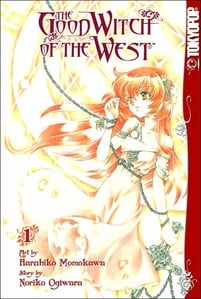Review
by Casey Brienza,The Good Witch of the West
GN 1-2
| Synopsis: |  |
||
The fifteen year old Firiel Dee lives a life of pastoral bliss in the peasant village of Sera Fields. If she has any problems at all, it's that her father, a bookish recluse who studies astronomy from his tower that everyone calls “the Professor,” seems to dote more on his apprentice Rune than his own daughter. But her attendance at a ball thrown by the noble Roland family at their castle soon reveals that Firiel is actually a descendant of the Star Queen—and a potential heir to the throne itself! And before she knows it, a sinister secret society seeking to subvert the queen's rule is after her and everyone she holds dear. |
|||
| Review: | |||
Beloved Japanese novelist Noriko Ogiwara loves Western children's fantasy literature, and she says that C. S. Lewis's The Chronicles of Narnia first inspired her to pen her own fantasy tales. Among her most popular literary efforts to date are The Good Witch of the West series of novels, and they have been adapted into a long-running manga of the same name with art by Haruhiko Momokawa. The manga has been serialized in Comic Blade since 2004 and has, in turn, been adapted into a thirteen episode anime television series which first aired in 2006. The following is a review of the first two volumes of the manga. Although the plot of the manga departs from the original novels in several significant ways, Ogiwara's considerable storytelling talent remains a palatable influence even when diluted, and even in manga form it reads like high quality children's prose literature. As such, there is also a heavy didactic element to be detected here; it affirms strength of character in the face of terrible adversity. For example, even after the destruction of her home and the apparent deaths of those who raised her, Firiel, normally a flighty, buoyant creature, forces herself to stand up and walk with purpose toward help. Clearly, Ogiwara really has taken her C. S. Lewis influence to heart, lifting both deep spiritual themes and superficial stylistic elements such as the decidedly Medieval European fantasy setting to the use of child—and especially female—protagonists from him. One is hard-pressed, in fact, to identify anything particularly “Japanese” about The Good Witch of the West purely from the standpoint of plot. If it were not for the names attached to it, this book may well have been written by an American or a European as easily as an Asian. Which certainly speaks well for the potential of its translation across cultures, and the story should please people who do not normally enjoy manga. Unfortunately, the textured complexity of the story sits quite uncomfortably with the cutesy style of the art. Momokawa draws in an airy, vapid hand that does nothing for the series besides diminish it and make it look like so much puffery. Though in other contexts his abilities would be more than serviceable, he readily admits at the end of volume one that he is not the most talented of artists and that he has trouble doing this good of a story justice—which is definitely more truth than modesty talking. Now, granted, Comic Blade is very much the otaku-centric publication, and it was probably the best visual interpretation one could hope to get under the circumstances. Still, the juxtaposition of a jaded, commercial anime look with a magical story designed to test the limits of a child's imagination is an unfortunate one. Unfortunate indeed. Who would ever suppose from the sparkly cover art that this manga, besides being a fantasy adventure and a coming of age tale, is also a gripping political drama? Most of the politicking after two volumes has been going on the periphery of the main narrative, but it is clear at the very least that the world governed by the Star Queen is embroiled in ideological conflict that is fast becoming a violent one. Some pressing questions: Is she a despot? Which side is actually in the right? What is all this stuff about “light” versus “darkness” supposed to mean? Science and mythology are also implicated in the conflict, though again how exactly has not yet been made explicit. All in all, the manga moves at a pleasant, leisurely pace but never slows to the point of stupor. More than half of volume one just sets the stage, giving the reader plenty of time to get to know Firiel, her childhood friend Rune, and the contours of her simple life…before totally upending everything she has heretofore known. By the end of volume one, her family is gone, and Rune has been kidnapped. No turning back. Most of volume two explores interior life of Firiel, Rune, and Firiel's cousin Adale. Though they manage to get Rune back, the darkness of his past seems to have taken hold once more, and he could become a thorny problem in the future. Firiel and Adale, for their parts, may look like cartoon child princesses, but they confront their very un-cartoonish problems with unexpected grace and strength. And while the roiling political conflict in which Firiel finds herself is still left frustratingly vague, even after two volumes, everything revealed thus far will undoubtedly leave the reader craving more. |
|
The views and opinions expressed in this article are solely those of the author(s) and do not necessarily represent the views of Anime News Network, its employees, owners, or sponsors.
|
| Grade: | |||
Overall : A-
Story : A
Art : B-
+ A pleasing adaptation of an excellent series of novels that are fast becoming classics in their own right. |
|||
| discuss this in the forum (4 posts) | | |||
| Production Info: | ||
|
Full encyclopedia details about Release information about |
||